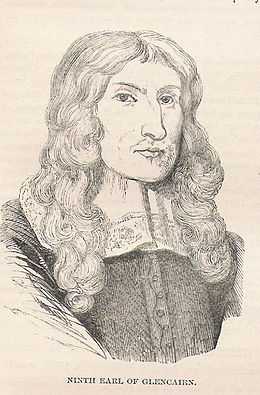William Cunningham, 9th Earl of Glencairn
William Cunningham, 9th Earl of Glencairn (1610–1664), was a Scottish nobleman, Lord Chancellor of Scotland, and a cavalier. He was also the chief of Clan Cunningham.

The eldest son of William Cunningham, 8th Earl of Glencairn, on 21 July 1637 this William obtained a ratification from King Charles 1st, under the Royal Sign Manual, of the original Glencairn Letters Patent of 1488.
He was sworn a member of the Privy Council of Scotland and in 1641 was appointed a Commissioner of the Treasury.
Royalist
The Earl supported the Royalist cause of his King, and in 1643 joined with the Duke of Hamilton and the Earls of Lanark and Roxburgh, in opposing the sending of a Scottish army into England to assist the English Parliamentary Army. For this loyalty he received a (now published) personal letter from the King.
He was appointed Lord Justice General by parliament in 1646. He knew of and is said to have "entered heartily into" the attempted rescue of Charles I in 1648, and was subsequently deprived by parliament of this post on 15 February 1649, under the Act of Classes. The parliament, now being dominant, at the instance of the Public Prosecutor, then passed a Decreet, on 2 March 1650, annulling the original Glencairn Letters Patent of 1488. (This was rescinded at the Restoration).
Glencairn then led an insurrection in the Highlands in 1653 (See: Royalist rising of 1651 to 1654) in favour of King Charles II, when General Monk had possession of Scotland. In January 1654 he was commissioned by Charles II to command the Royal forces in all of Scotland, numbering some 3,500 men, but he later handed his command to General Middleton. About this time Glencairn and Lieutenant-General Sir George Munro, 1st of Newmore engaged in a duel with both pistols & swords two miles to the south of Dornoch. Munro had poured scorn on the quality of their forces and Glencairn had defended them, challenging Munro, who lost but was only wounded. Middleton initially placed the Earl under arrest, but the Earl left the army a fortnight later.
He was then arrested by Monck in 1655, who later permitted him to return home. Glencairn was excepted from Cromwell's Act of Grace and Pardon.
Restoration
He was one of the peers whom Monk called to the Convention he summoned when he was about to march into England in 1659. It was at this Convention that Glencairn called for Monk to declare for a free parliament.
Upon the RestorationGlencairn waited upon King Charles II at London, when he was again sworn a Privy Councillor and appointed Sheriff Principal of Ayrshire. On 19 January 1661, he was constituted Lord Chancellor of Scotland for life, upon the resignation of the Earl of Loudoun.
Glencairn was Chancellor of the University of Glasgow from 1660, and was one of the principal advisors of the re-establishment of Episcopacy in Scotland. He was not, however, opposed to Presbyterianism, and the subsequent bitter disputes between the two religious factions greatly distressed him and affected his health.
The Earl died at Belton, East Lothian, on 30 May 1663, aged 54 years. He was buried, with great pomp, in the south-east aisle of St. Giles Cathedral in Edinburgh, on 28 July following. He had a daughter, Margaret, who married in 1662, John Hamilton, 2nd Lord Bargany, a descendant of James Hamilton, 2nd Earl of Arran (1517-1575).[1]
See also
- Kilmaurs place A property of the 9th Earl of Glencairn.
References
This article incorporates material from a source in the public domain.[2]
- ↑ G. (George) Harvey Johnston (1919). Heraldry of the Hamiltons with Notes on all the males of the Family - Descriptions of the Arms, Plates and Pedigrees. W. & A.K. Johnston Limited.
- ↑ Anderson, William (1867). The Scottish Nation, Volume II. Fullarton & Co. pp. 312–3.
| Legal offices | ||
|---|---|---|
| Preceded by Sir Thomas Hope |
Lord Justice General 1646–1649 |
Succeeded by 6th Earl of Cassilis |
| Academic offices | ||
| Preceded by John Thurloe |
Chancellor of the University of Glasgow 1660–1661 |
Succeeded by Andrew Fairfowl |
| Political offices | ||
| Preceded by 1st Earl of Loudoun |
Lord Chancellor of Scotland 1661–1664 |
Succeeded by 1st Duke of Rothes |